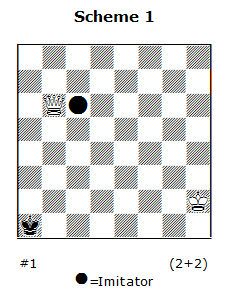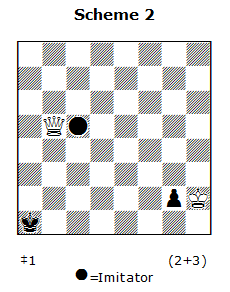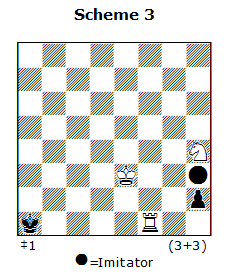|
I should say that I’ve started to enjoy Imitator, its features with a different moves and conditions, implementation by Popeye and WinChloe.. and how much of it is based on the definition.
At first, I’ve tried to find more about the inventor’s definition, but all I have is:
I’ve got to know that on Chess Composers blog the information about Imitator’s inventor came from the Retro Corner – http://www.janko.at/Retros/Glossary/Imitator.htm (written by Philippe Schnoebelen) – where it is said:
The Imitator (invented by Th. Kok in 1939) is a fairy piece depicted as a big black spot, and denoted by “I”. It does not move by itself, but it imitates every move by normal pieces. Moves that cannot be imitated are illegal, so that the Imitator acts as a constraint on possible moves.
The Imitator does not belong to any side. It cannot be captured.
And one more interesting addition – I don’t know either it is a part of the definition, or it is based on the implementation is solving programs:
Castling is imitated by decomposing into a King move followed by a Rook move.
This addition made me think about the features Imitator can add to the castling move:
IMITATOR with Castling
(Imitator’s behavior is analogical in the last versions of the both programs – Popeye and WinChloe)
1. Castling short – the both moves are imitated in a sequence, the first is a King, the second is a Rook. But as a result Imitator returns on its initial square.
F.i., in the scheme below:
white ke1 qe5 rh1 | bla kf3 pg4 | imitator a4
after Kg1 Imitator goes to c4, but after Rf1 Imitator returns again on a4!
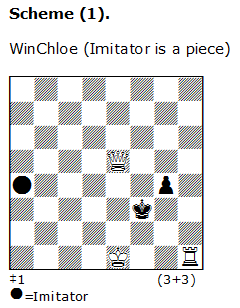
1.0-0{Ia4}‡!
Popeye (Imitator is a condition)
beg sti #1
pie whi ke1 qe5 rh1
bla kf3 pg4
con imitator a4 end
#1 3 + 2
Imitator a4
1.0-0[Ia4] # !
2. Castling long – again, the both moves are imitated in a sequence, the first is a King, the second is a Rook. But this time a place of return for Imitator is one square right from its initial square.
F.i., in the scheme (2) below:
white ke1 qe5 ra1 | bla kd3 pc4 | imitator g4
after Kc1 Imitator goes to e4, but after Rd1 Imitator returns to the right and comes on h4 (one square to the right from its initial position)!

1.0-0-0{Ih4}
Castling with Imitator gives some special features, like in the Scheme (3):
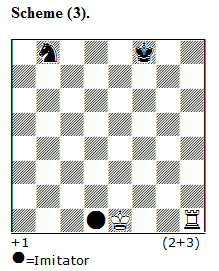
The only solution here is 1.0-0+! – where Imitator goes together with Kg1 (If1) and than with Rf1 (Id1) – returns to its initial position!
A check with 1. Rf1?? is impossible as together with this move Imitator goes to b1, and a Rook from f1 can’t give a check as a capture RxKe8 can’t be imitated as b8 is blocked!
————
Also, the en passant-discussion of the last weeks couldn’t leave me indifferent, so I’ve checked the
IMITATOR with En Passant
(Imitator’s behavior is analogical in the last versions of the both programs – Popeye and WinChloe)
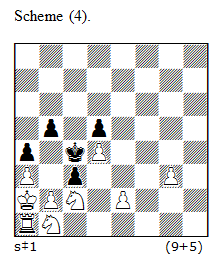
Without an Imitator the mates would be:
1.b4! axb3 e.p.‡; 1.b3+! axb3‡.
Adding the Imitator in a Scheme (5) changes a situation cardinally! Now it is important, where should play the white Pawn – on b4 or b3. It is not very visible from the first glance why 1.b3+? Doesn’t work for (a) and 1.b4? doesn’t work for (b).
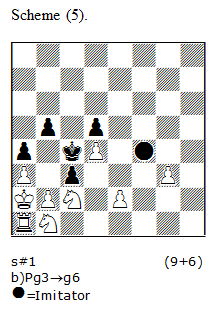
a) 1.b4{If6}! axb3 e.p.{Ig5}# (1.b3?(If5) axb3+(Ig4) but 2.Kb2(Ih4)!! and the capture cxb3 is impossible because the Imitator h4 is blocked and can’t come on g3!!)
b) 1.b3{If5}! axb3 {Ig4}# (1.b4(If6)? 2.axb3 e.p(Ig5)+ but 2.Sxc3(Ih7)!! and the capture bxa2 is impossible because the Imitator h7 is blocked and can’t come on g6!!)
————–
That’s all for today :). But further I’d like to discuss with you some combinations of Imitator with other conditions, especially differently implemented in Popeye and WinChloe.
And.. I’ve started to compose my first problem with Imitator!
|
















 Imitator – definition, features, implementation
Imitator – definition, features, implementation








